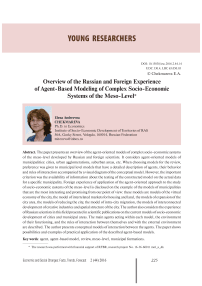Overview of the Russian and foreign experience of agent-based modeling of complex socio-economic systems of the meso-level
Автор: Chekmareva Elena Andreevna
Журнал: Economic and Social Changes: Facts, Trends, Forecast @volnc-esc-en
Рубрика: Young researchers
Статья в выпуске: 2 (44) т.9, 2016 года.
Бесплатный доступ
The paper presents an overview of the agent-based models of complex socio-economic systems of the meso-level developed by Russian and foreign scientists. It considers agent-based models of municipalities: cities, urban agglomerations, suburban areas, etc. When choosing models for the review, preference was given to municipal level models that have a detailed description of agents, their behavior and rules of interaction accompanied by a visual diagram of the conceptual model. However, the important criterion was the availability of information about the testing of the constructed model on the actual data for a specific municipality. Foreign experience of application of the agent-based approach to the study of socio-economic systems of the meso-level is disclosed on the example of the models of municipalities that are the most interesting and promising from our point of view: these models are models of the virtual economy of the city, the model of interrelated markets for housing and land, the models of expansion of the city area, the models of reducing the city, the model of intra-city migration, the models of interconnected development of creative industries and spatial structure of the city...
Agent, agent-based model, review, meso-level, municipal formations
Короткий адрес: https://sciup.org/147223821
IDR: 147223821 | УДК: 330.4 | DOI: 10.15838/esc.2016.2.44.14
Текст научной статьи Overview of the Russian and foreign experience of agent-based modeling of complex socio-economic systems of the meso-level
In the modern age of active development of information technology, the efficiency of public administration at any level increasingly depends not only on the volume and accuracy of information that the government have about the social and economic changes taking place in their territory, but also on the ways that are used in processing such data. The amount of information which the decision makers have to deal with, is growing every day. At the same time, we agree with A. Musaev and A. Shevchik , who note that the human brain cannot perceive more than three or four interrelated parameters of a dynamic process. Therefore, to develop the most effective management decisions, it is advisable to involve “cognitive advisors” capable of processing hundreds or thousands of interrelated parameters [13, p. 50]. Such cognitive advisors, in our opinion, are computer agent-based models that take into account the characteristics and peculiarities of behavior of economic entities at the micro-level; these models help forecast the processes at the macro- and meso-level and test different options of controlling actions.
Agent-based models belong to a special class of models based on individual behavior of agents and created for computer simulations [2, p. 24]. They represent an artificial society consisting of independent interacting agents, each of which has a given set of personal characteristics (“resources”), target functions (“interests”) and follows the rules of behavior that determine its reaction in various situations involving the scope of its interests [14, p. 5].
The works of B. Heath, R. Hill and F. Ciarallo [25] show that agent-based modeling is becoming more and more popular, the number of articles on the subject is steadily increasing from year to year, with about half of all agent-based models being designed in the field of the social sciences and economics, modeling various social and economic phenomena and processes.
The majority of agent-based models in socio-economic field is represented by macroeconomic models. Foreign publications introduced the notion of “MacroABM” as a result of the widespread use of agent-based modeling in the study of macroeconomic processes and systems to denote this class of models [27]. EURACE [23] – an agent-based computable model of the European economy is a telling example of macro-level models.
Micro-level agent-based models are also widespread because they are used in optimization of business processes in order to increase the profits of enterprises and organizations. The smallest segment is occupied by agent-based models of the meso-level (from the Greek word mesos – middle, intermediate), i.e. the models of cities and regions that are less common in foreign and domestic publications.
However, it should be recognized that some models of the macro-level can be adapted to the meso-level. At the same time, this is not always possible, since agent-based models of socio-economic systems of the meso-level have their own characteristics that consist in specific types of agents and environment. According to the authoritative opinion of Academician V.L. Makarov and Doctor of Economics A.R. Bakhtizin, any real life objects can be agents in agent-based models; however, the main objective of their consideration in the framework of the model is their correct specification. In particular, the models of socio-economic systems usually have aggregated agents that represent either the industry or region, or household [9, p. 21].
The goal of the present paper is to review agent-based models of complex socioeconomic systems of the meso-level developed by Russian and foreign scientists. To achieve this goal, we considered agent-based models of municipalities: cities, urban agglomerations, suburban areas, etc. that we find most interesting. At that, for each model we described major agents, the environment of their functioning, the rules of interaction between the agents and the external environment. The paper also provides visual imagery of conceptual models for agents’ interaction, discloses the possibilities and examples of practical application of the agent-based models described in the study.
The information base of the research is domestic and foreign publications on agentbased modeling, in particular, the articles and monographs of scientists of the Central Economics and Mathematics Institute under the Russian Academy of Sciences, who actively develop this research direction in Russia; international publications available on the Internet served as information sources as well.
I. Overview of foreign experience
Currently described in foreign publications, the practice of agent-based modeling of socioeconomic systems of the meso-level basically simulates the development of cities, urban agglomerations and suburban areas. As we know, modeling urban development that has a long history is represented by a wide range of methods, including social physics, cellular automata and so on [20]. The history of development of this direction is reflected very well in the works of M. Batty, the world’s leading expert on urban modeling [19], who considers the city as a complex socioeconomic system of the meso-scale [18].
A study of urban development with the help of agent-based modeling is a relatively new and promising direction. However, scientific community has accumulated considerable experience in building agent-based models of urban socio-economic space. Some of them can be found in a review article by the famous English specialist in agent-based modeling A. Heppenstall and her co-authors [26]. However, the purpose of this review is somewhat different from our goals, because our review contains extensive coverage of publications, but very superficial description of the nature of the models themselves. The authors highlight the purpose of the models described; as for the design of the models, which is, in our opinion, the most interesting, is given very little attention. In addition, this review focuses more on the models within the scope of the interests of authors, and ignores many other models that deserve attention.
When selecting agent-based models for our review, preference was given to the models at the municipal level that have a detailed description of agents, their behavior and rules of interaction, accompanied by a visual diagram of the conceptual model. At the same time, an important criterion was considered the availability of information about testing the models on actual data for a specific municipality. It means that abstract theoretical agent-based models that are intended for practical use were deliberately excluded from the review.
The Virtual Economy Model . The work by P. Cech, P. Tucnik, V. Bures and M. Husrakova [31] proposes an agent-based model of the virtual economy designed for the study of economic processes and progress in the city of Hradec Kralove (Czech Republic). The model simulates the processes of production and consumption in the real economy and contains four types of autonomous agents:
-
1) consumers or C-agents;
-
2) producers or F-agents (from the English word “factory”);
-
3) mining companies or M-agents;
-
4) transport or T-agents.
According to the authors, the model they propose is similar to the virtual economy model designed by their Japanese colleagues [22], which was simplified, since it had more specific productions and a more complex network of relations between its agents than was required in the study. In particular, the Czech model unlike the Japanese model does not include banking operations and the work of the government, that is why agents such as “the Bank”, “the Central Bank” and “the Government” were excluded. In addition, instead of four specialized agents representing agriculture, bakery industry, metallurgy and mechanical engineering, one agent was introduced – “the Producers” and a new type of agents – the “Transport” – was added.
The behavior of the agents in the model is as follows:
-
1. Consumer agents can buy goods of three types: essentials, normal goods and luxury items. The structure and rate of consumption are determined by the individual consumption function that depends on the welfare of agents, which in turn is determined
-
2. Producer agents consume raw materials and other products and produce the final product purchased by consumer agents, or the intermediate product purchased by other manufacturers. The raw materials and products that are purchased and their proportion are determined by the consumption function, and the range of products manufactured is specified by the production function. The output depends on the technology used and on the skills of consumer agents employed in production.
-
3. Mining companies are responsible for converting natural resources into raw materials used by producer agents. Here each agent of this type provides only one kind of raw material. The cost of production is determined by the function of consumption, reflecting the necessary energy and technology.
-
4. Transport agents are intermediaries between mining companies and producer agents. The task of the transport agent is to find the best route. The performance of the transport agent is determined by the speed of movement, capacity and technology. The transportation cost depends on the distance.
by the job and qualification. The agents can dispose of their wealth, making a choice between investment in advanced training and investment in consumption.
In addition to all of the above, consumers, manufacturers and transport agents can be united in small communities that the model refers to as “colonies”. Colonies compete for resources and have two basic characteristics: position in space and size (population size). The success of the colony is determined by its wealth, which is calculated as the sum of welfares of all its agents ( fig. 1 ).

Figure 1. Conceptual model of the virtual economy (Hradec Kr a lov e )
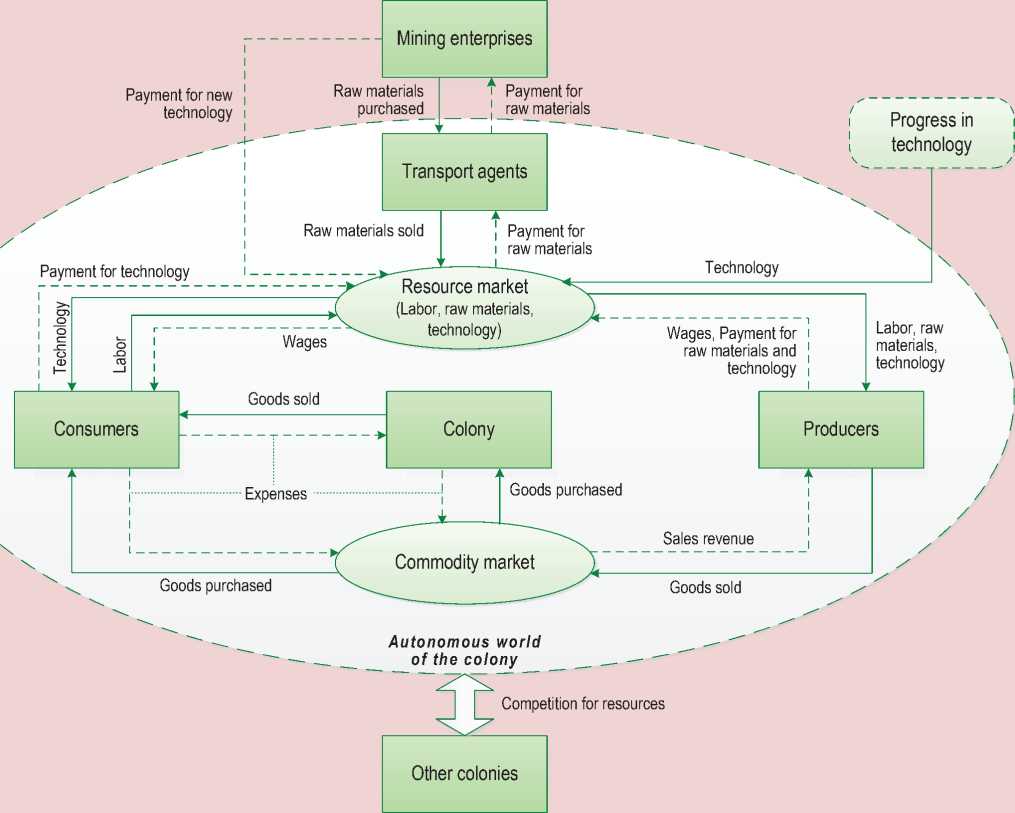
Flows of labor, raw materials and goods
Money flows
Source: Cech P., Tucnik P., Bures V., Husrakova M. Modelling Complexity of Economic System with Multi-Agent Systems. 5th International Conference on Knowledge Management and Information Sharing (KMIS 13), Vilamoura, Algarve, Portugal, September 19-22, 2013. Pp. 464-469.
In general, the agent is described as a vector of eight variables:
AGENT = (pos, w, s, con, e, pro, mob, a), where pos – position in two-dimensional Cartesian space, w – welfare (w>=0, i.e., debt is not allowed),
s –storage capacity of the warehouse, con – consumption volume, e – efficiency, pro – production function, mob – mobility,
-
a – affiliation with the colony.
The colony, in turn, is defined by five variables:
COLmetaagent = (pos, s, w, cw, CP), where cw – creditworthiness of the colony, CP – colony population (number of agents) [21].
The primary simplified computer model of the virtual economy described by the authors is implemented by them on the NetLogo platform and simulates processes such as: extraction of raw materials, transfer of raw materials to transport agents, transportation of raw materials to the colony, detection of obstacles during transportation (swamps, forests, water reservoirs, sand), production, purchase, sale and final consumption of the products by consumer agents. The final model, according to the authors, should be consistent with the behavior of economic entities of Hradec Kralove and based on real statistical data.
Coupled Housing and Land Markets Model (CHALMS) is one of the most famous economic agent-based models of meso-level [30] – a model of interrelated markets for housing and land, developed by N. Magliocca and describing the dynamics of a hypothetical suburban area ( fig. 2 ).
The main agents in the model are landowners, consumers and developers. The model simulates the gradual transformation of suburban agricultural land into residential areas of the city as a result of actions of the agents in the land and housing markets. According to the authors, this model reflects main trends in the development of most suburban areas of the United States.
Urban Expansion models . The agent-based model of the Chinese city of Changsha developed by H. Zhang, Y. Zeng, L. Bian, and X. Yu [32] also contains three types of agents: urban residents, farmers and government. The model considers resident agents, who choose a new place of residence, as one of the main
Figure 2. Conceptual model of coupled housing and land markets
Housing
Housing
Population growth (t+1)
Update pred. models (t+1)
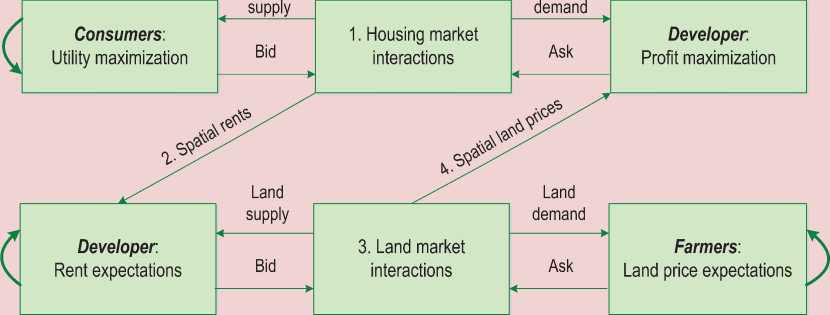
Update pred. models (t+1)
Note: the numbers indicate the sequence of events within one model time step.
Source: Magliocca N., Safirova E., McConnell V., Walls M. An Economic Agent-Based Model of Coupled Housing and Land Markets (CHALMS). Computers, Environment and Urban Systems , 2011, no. 35, pp. 183-191.
driving forces behind urban expansion. Here, two types of resident agents are considered: new residents coming from outside, and existing residents who move to a new place of residence. It is assumed that when searching for a new place of residence, the agent seeks to maximize the utility function:
U -а-С + В • L + у-Е +ц
-
X , У x , У X , У Y X , y ^ x , y ,
where C, L and E – standardized transport accessibility, land value and natural value of the place (x, y), respectively,
-
а, в и у — the weight of each factor for a specific agent ( а + в + у = 1 ),
^ „ — random residual. The introduction of xly weight coefficients helps take into account the fact that the significance of the factors considered when choosing a place of residence for agents with different income levels and family composition is not the same.
Searching for a more comfortable life, farmer agents strive, on the one hand, to live closer to the city and “civilization”, on the other hand – not to lose the land that feeds them, because it is the land situated near the city limits and major roads that will most likely be transferred to the city. Decisionmaking on the part of farmer agents in the model depends on a whole range of factors: the share of protected agricultural land, the proportion of land for development and areas of possible development, distances to railroads and highways, distances to main urban roads and the city center, population density etc.
The government in the model is the agent of a special type: it has no spatial characteristics unlike agents of the other two types; however, it can make decisions that promote the most rational use of lands, ensure sustainable development of the city while protecting and preserving valuable agricultural land. The model is based on actual statistical data on the socio-economic development of Changsha since the 1990s, it uses a GIS map of the city and is implemented as a cellular automaton.
Another example of agent-based models of urban growth is the Greater Toronto Area expansion model [33], also mentioned in the article [7, p. 34]. The model contains three types of agents: residents, developers and government ( fig. 3 ). Like in the “Chinese” model described above, here we consider two kinds of residents: new and existing. New residents in search of a place of residence encourage developers (who, of course, are profit-oriented) to design housing development projects and send them for consideration to the government and the residents of the houses adjacent to the area of potential development. Depending on the fact whether the existing residents have or do not have any objections, the government makes a final decision about the approval or rejection of the project and in case of positive decision new territories are developed and the city expanded.
Intra-Urban Migration Model . Agent-based modeling of the major reason for the expansion of cities – intraurban migration – is considered in the work of American scientists S. Sun and S.M. Manson [34]. The main agents in the model are households that create demand in the real estate market, developers that form the supply of new housing, and the government that regulates the use of land. The authors carry out the modeling of intraurban migration in four stages: 1) determination of characteristics of the environment and
Figure 3. Conceptual model of urban expansion (the Greater Toronto Area)
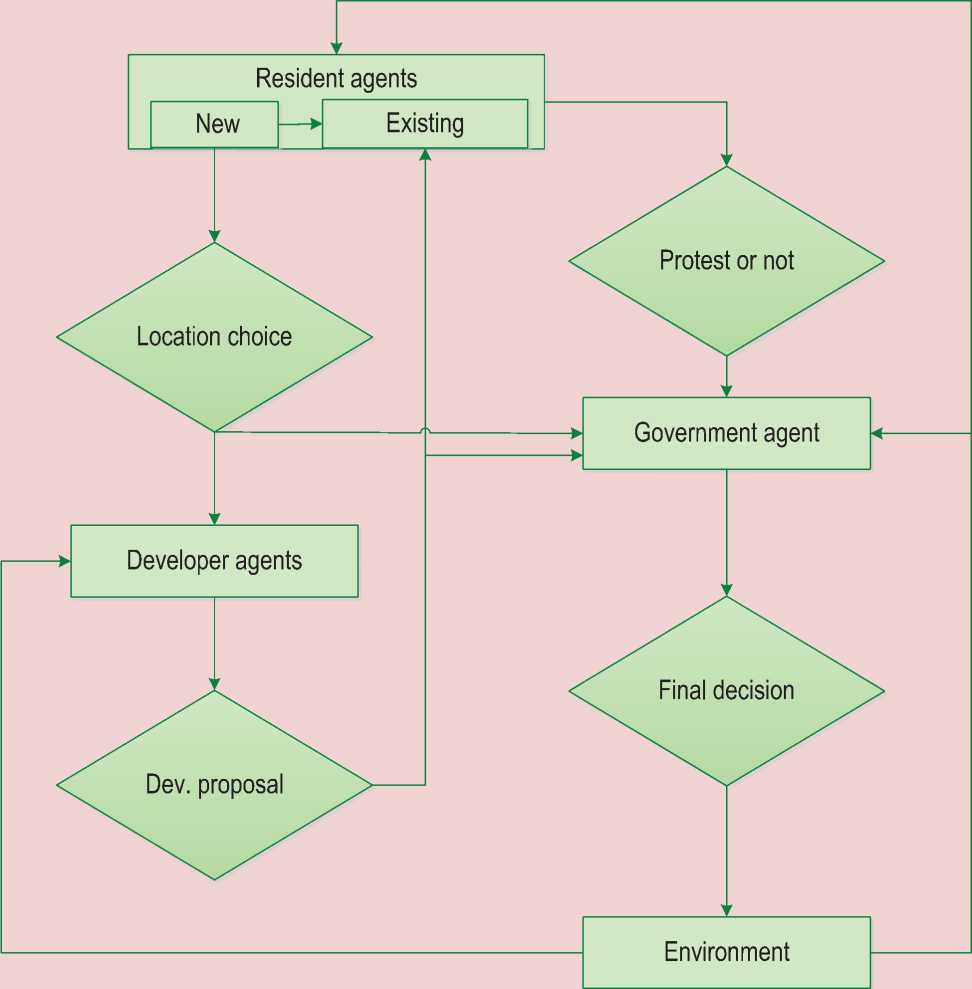
Source: Rui Y., Ban Y. Multi-agent Simulation for Modeling Urban Sprawl In the Greater Toronto Area. Proc. of the 13th AGILE International Conference on Geographic Information Science. - Guimaraes (Portugal), 2010. Available at:
spatio-temporal framework, 2) uploading the data about the agents, 3) running the model, 4) analyzing the model output ( fig. 4 ). The model is calibrated and verified using actual data on the Metropolitan area of Minnesota, which is formed by the so-called Twin Cities: Minneapolis and adjoining Saint Paul.
Shrinking City Model . The reverse process – the shrinking of the city – is considered in the work of German researchers D. Haase, S. Lautenbach, and R. Seppelt [24] who used agent-based modeling for studying migration and land use in Leipzig. The computer agentbased shrinking city model that authors called
Figure 4. Main stages of modeling intraurban migration (Twin Cities)
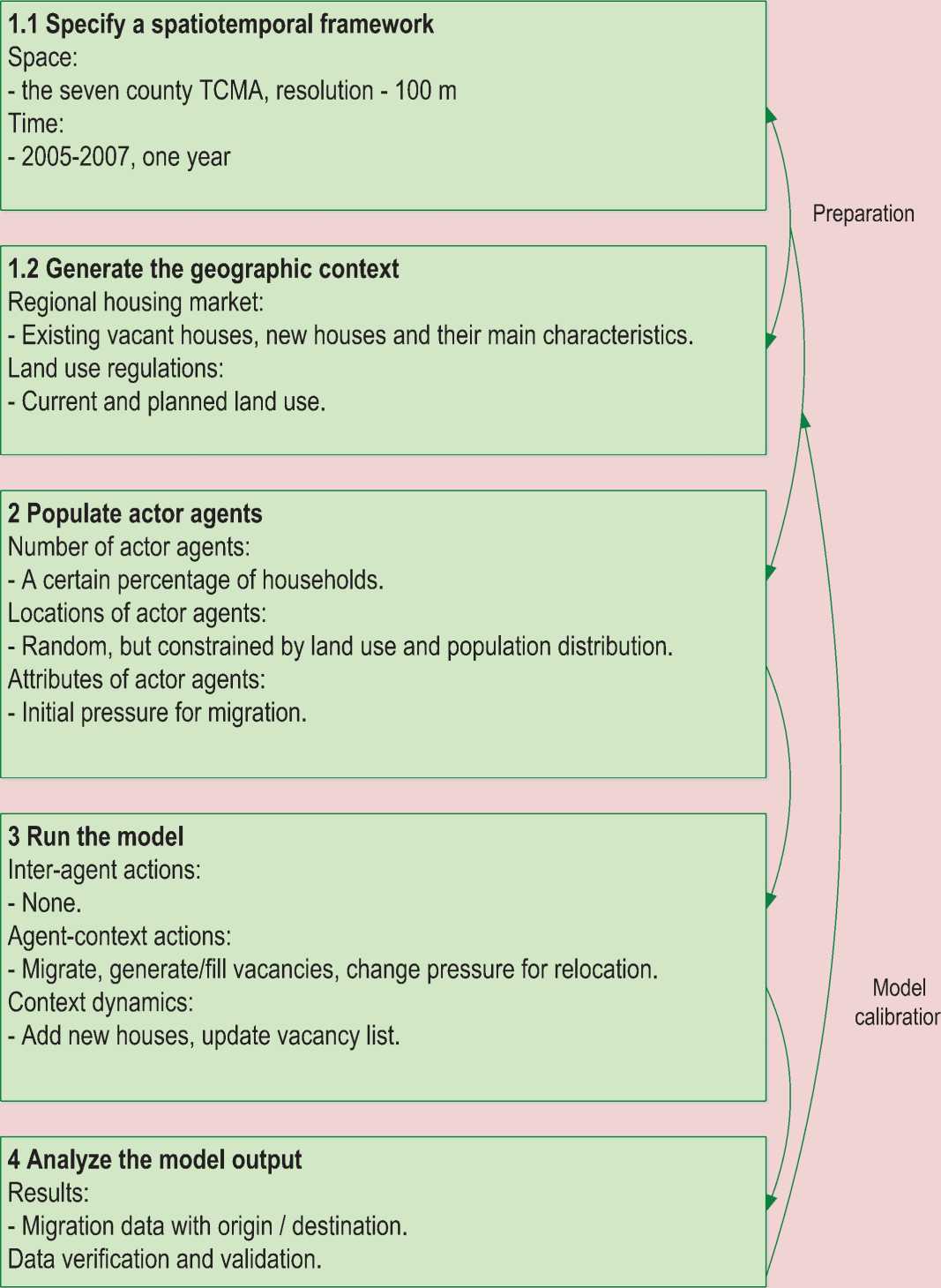
Source: Sun S., Manson S.M. Simple Agents, Emergent City: Agent-Based Modeling of Intraurban Migration. Computational Approaches for Urban Environments. Berlin: Springer, 2015. Pp. 123-147.
RESMOBcity is based on a conceptual model ( fig. 5 ), consisting of three sections:
-
1. “Population” component: population dynamics is determined by migration increment, birth rate and mortality and, in turn, affects the types of households and life cycles.
-
2. “Space” component: each point of the urban space, besides its territorial jurisdiction, describes a set of characteristics reflecting the conditions of residence in this place: security, crime, household pattern, available educational and medical
-
3. “Decision-Making” component: each household assesses the attractiveness of the place of residence and makes a choice between relocation and preservation of its former residence.
facilities, shopping centers, recreation and entertainment facilities, transport accessibility (roads), type of residential development, the cost of purchasing and renting property.
As the result of resettlement of households, the least appealing housing is released, and if it is not in demand for a long time (over 5 years), then it is demolished.
Figure 5. Shrinking city conceptual model (Leipzig)
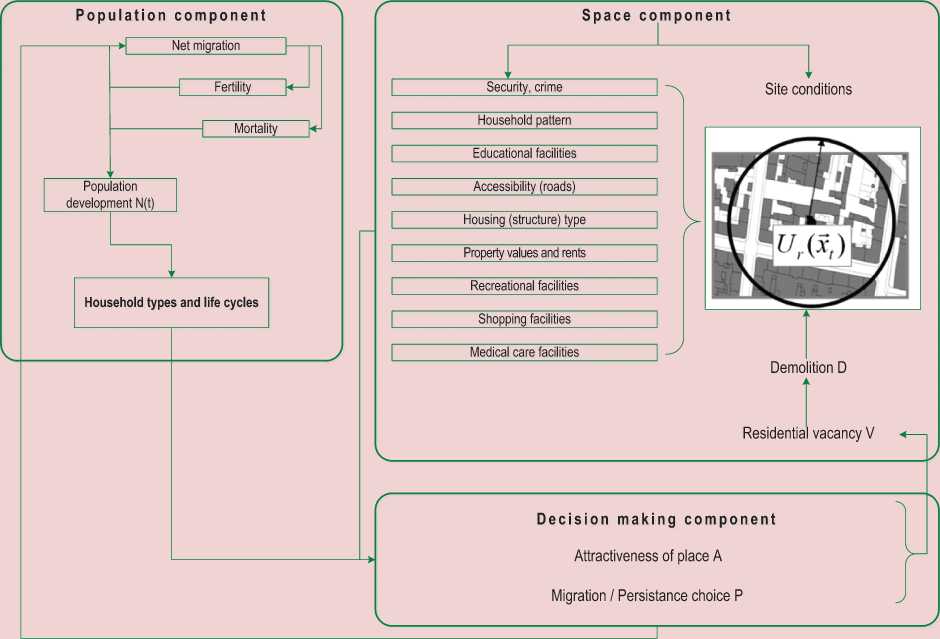
Source: Haase D., Lautenbach S., Seppelt R. Modeling and Simulating Residential Mobility in a Shrinking City Using an Agent-Based Approach. Environ. Model. Softw., 2010, no. 25, pp. 1225-1240.
Creative Industries Urban Model . H. Liu and E.A. Silva [28, 29], researchers at Cambridge University, developed an agent-based model of interrelated development of creative industries and spatial structure of the city. The agentbased model is implemented by the authors in NetLogo in the form of a computer model called CID-USST and tested on data of the Chinese city of Nanjing. The model contains three types of agents: creative firms, creative workers and urban government ( fig. 6 ).
Firms can appear and disappear, hire workers and increase the staff or fire workers and reduce their staff, move from one office to another. Creative workers can also appear and disappear, and change their place of residence. Urban government is responsible for the planning of urban land use and it can implement policies to support both private firms and some urban areas, making or canceling the policy decisions regarding the use of urban land. Each land plot in the model is characterized by a set of properties, including: location, land use type, topography, suitability for use, city neighborhood, development quality, etc. Some of these properties may change depending on the actions of the agents, and, on the contrary, dynamics of properties of land has an impact on the actions of agents in the model.
Figure 6. Conceptual model of the interrelated development of creative industry and spatial structure of the city (Nanjing)
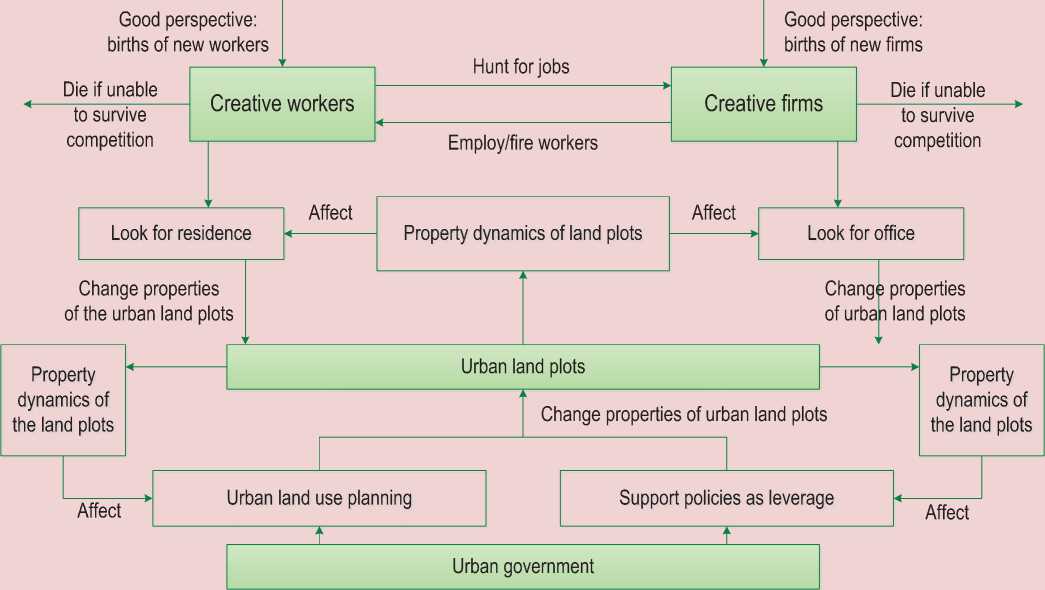
Source: Liu H., Silva E. A. Creative Industries Urban Model: Structure and Functioning. Urban Design and Planning , 2015, vol. 168, no. 2, pp. 88-100.
At the end of our review of international experience, we note that the models described above do not cover the whole variety of agentbased models of the meso-level developed abroad1; however, they are, in our opinion, the most interesting and well-researched, as evidenced by their detailed description in the articles that we have analyzed. Also, the focus of the majority of developers on the practical application of the models designed and on the use of real statistical data on municipalities sets good prospects for further development of models with quality calibration and validation.
So, answering the question indicated in the title of his article “How Good are Agent-Based Models at Simulating Individuals and Space in Cities?”, A. Heppenstall, A., N. Malleson and A.Crooks [26] conclude that although the urban agent-based modeling, due to its “descent” to the micro-level and greater detail, led to a deeper understanding of local intraurban processes and urban dynamics, however, there remains a number of unresolved problems related to calibration and validation of agent-based models, modeling of individual behavior, the quality of input data, etc. Summing up their reasoning, the authors point out the existence of great potential of agent-based modeling as a method to simulate urban development, noting that the solution of selected problems is of crucial importance if agent-based modeling is going to be applied in practice in the future to help managers develop sustainable and smart cities.
-
II. Review of Russian experience
Agent-based modeling in Russia began to develop somewhat later than abroad, and is not widespread yet. For this reason, the number of agent-based models developed in our country is much fewer, and there are very few agent-based models of complex socio-economic systems. However, it is worth mentioning that, despite this fact and despite a relatively small experience of agent-based modeling, the quality of the models already developed is very high. First and foremost, it is a merit of researchers at the Central Economics and Mathematics Institute under the Russian Academy of Sciences, they actively develop this direction in Russia. To date, CEMI RAS specialists developed the following models:
– integrated agent-based model of socioeconomic development of megalopolises [15];
– multi-agent model of municipal formations in the region [7];
– demographic model of the conditional region [6];
– agent-based regional model “the Governor” [14];
– agent-based demographic model “Russia” [8] and other models.
The researchers sum up the accumulated experience of agent-based modeling in two books: “Agent-Based Economic Models” [2] and “Social Simulation – a New Computer Breakthrough (Agent-Based Models)” [10]. Let us consider the meso-level models.
Model of Urban Socio-Economic Development . The integrated agent-based model of socio-economic development of megalopolises [15], developed by M.R. Fattakhov was named CABMUD (Complex Agent-
Based Model of Urban Development). It consists of five sections: two types of agents and three types of environment (fig. 7). The main agents in the model are people – inhabitants of the megalopolis, and also municipal enterprises and organizations. The environment of the model is represented by city districts, their public roads and public transport lines. In the process of functioning of the model, its agents-people interact with the other kind of agents – enterprises (the agent-agent type of relation), i.e., they either are already working and receive a monthly income or are on the job market searching for a job. Living in the districts, they interact with the environment of the model (the agent- environment type of relation). Here they pay for the cost of living (utility bills, rent).
The agents can change the district of their residence based on their preferences or on current financial situation. Moving between home and work, agents-people interact with two types of environment – public roads and public transport. The choice of transport type influences the amount of monthly expenses and the time spent by the agents on travelling. The agents of this type have the following characteristics: age, memory, available money, monthly income, district of residence, district of work, time when his/her working day starts, monthly transportation costs, presence or absence of a personal vehicle. The agents-
Figure 7. Conceptual scheme of an agent-based model of the development of the megalopolis (Moscow)
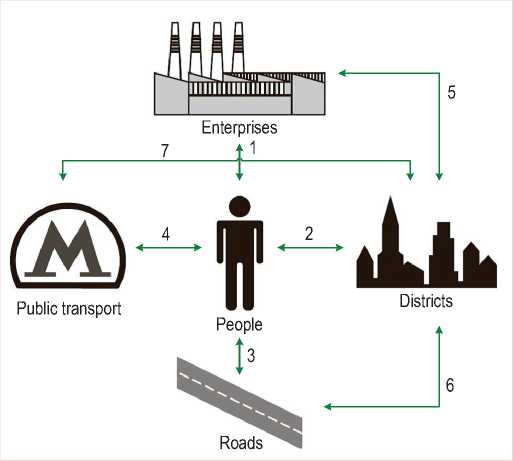
Legend: 1 – interaction between agents: people work at the enterprises and earn wages or search for a job, 2 – interaction with the environment: agents-people live in the city districts; 3 – interaction with the environment: agents-people use public roads for travelling; 4 – interaction with the environment: agents-people use public transport; 5 – interaction with the environment: agents-enterprises located in the city districts pay monthly rental fee; 6 – implementation of the principle of hierarchical structure of the environment: public roads are located in the city districts; 7 – implementation of the principle of hierarchical structure of the environment: public transport lines pass through the city districts.
Source: Fattakhov M.R. Agento-orientirovannaya model’ sotsial’no-ekonomicheskogo razvitiya Moskvy [Agent-Based Model for Socio-Economic Development of Moscow]. Ekonomika i matematicheskie metody [Economics and Mathematical Methods], 2013, no. 2, pp. 30-42.
people can be in one of four states: content, neutral state and discontent in the waiting state ( fig. 8 ). The CABMUD model created by M.R. Fattakhov makes it possible to develop long-term forecasts and scenarios of socioeconomic development of the city based on the level of comfort of its residents, and also to receive the quantitative evaluation of management decisions’ results. The model was tested on the example of Moscow [16] and showed good results.
At present, specialists at CEMI RAS, together with their colleagues from the NorthWest Institute of Management at the Russian Presidential Academy of National Economy and Public Administration are developing a large-scale agent-based model of the social system of Saint Petersburg [9, p. 23].
The Model of Municipalities . The agentbased model of the municipality, developed by E.D. Sushko deserves special attention [7]. It contains two types of agents: agents-natural persons (inhabitants of the municipality) and agents-legal entities (enterprises and organizations operating on the territory of the municipality). Agents-organizations are divided into two categories: enterprises of the real sector and organizations of the social sphere. The author implements the principle of hierarchical structure of the model: the agents-natural persons are the agents of the first hierarchy level, and the enterprises and
Figure 8. States of human agents in the CABMUD model
Pleased
Displeased
Discontent
Content
Sell the car
Change the place of residence
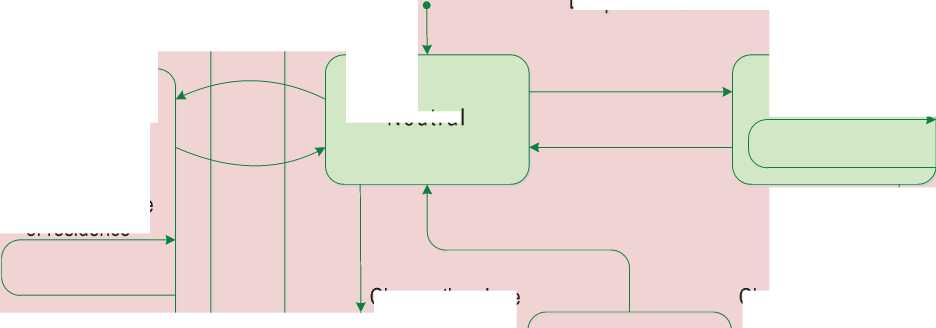
Neutral
Change the place
Expectation
Move 35 – 60
Move <35
Change the place \of employment
Move >60
Move 35 – 60
Move <35
Purchase a car


Source: Fattakhov M.R. Agento-orientirovannaya model’ sotsial’no-ekonomicheskogo razvitiya Moskvy [Agent-Based Model for Socio-Economic Development of Moscow]. Ekonomika i matematicheskie metody [Economics and Mathematical Methods], 2013, no. 2, pp. 30-42.
organizations that employ residents of the municipality are the agents of the second level. Municipal formations in the simulation of the region will become the agents of the third level of the hierarchy. Moreover, the agents of the same level in the model do not directly interact with each other.
Each agent in the model has a certain set of individual characteristics. For agents of the first level, such characteristics are the level of education and health, work experience, etc. The main characteristics of the agents of the second level are as follows: fixed assets, available financial means, labor potential of employees, etc. The status of the agents in the model is influenced by numerous environmental factors.
The behavior of agents of both types is due to their “system of values” (preferences) and is simulated on the basis of target functions. The people agents who work at the enterprises and organizations in the municipal entity analyze the information available on the external environment and their own place in it, and, like in M.R. Fattakhov’s model described above, shift in accordance with their system of values to one of the three states that the author refers to as “normal”, “discontent”
Figure 9. Agent’s behavior pattern in the model of the municipal formation
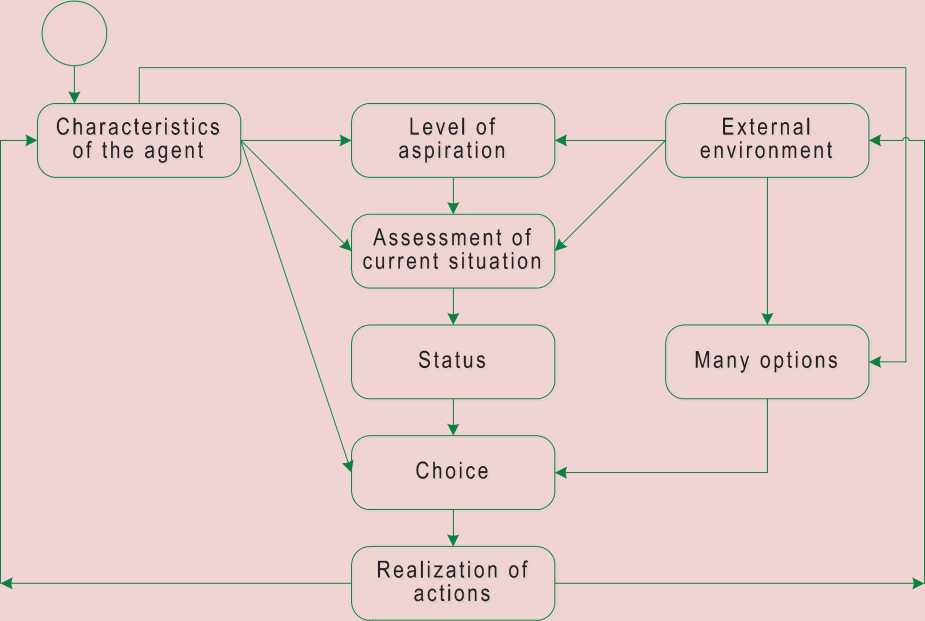
Source Sushko E.D. Mul’tiagentnaya model’ regiona: kontseptsiya, konstruktsiya i realizatsiya: Preprint # WP/2012/292 [Multi-Agent Model of the Region: Concept, Design, and Implementation: Preprint # WP/2012/292]. Moscow: TsEMI RAN, 2012. 54 p.
and “critical”. The normal state is the initial state of the agents in the model, and the critical state indicates the need for urgent action to change the situation. The general scheme of agents’ behavior in the model is represented in Figure 9 .
The agent-based model is tested on the example of municipal districts of the Vologda Oblast with reference to its map and implemented by the researcher in the form of a custom software product developed in the simulation software AnyLogic2 produced by “The AnyLogic Company” (Russia) formerly known as “XJ Technologies”. It is important to emphasize that the computer model focuses on practical application in managerial activities and enables testing different strategies of management of revenues and expenditures of municipalities’ budgets. Testing is done by changes in the controlled parameters of the model, in particular, budget expenses on the social sector and the tax burden.
It is worth mentioning that, along with the statistical data of the Federal State Statistics Service, the sociological data presented by ISEDT RAS researchers in the monograph “Local Self-Government in Regional Development” served as the information base for the creation of the computer-based agent-based model of municipal formations of the Vologda Oblast [1], and that the methodological approach to the assessment of labor potential described in the monograph “Labor Potential of the Region” [5] was used in the process of designing the model.
The multi-agent simulation model of the municipality developed by the Yekaterinburg team of scientists supervised by N.A Begunov [3] can be named as similar to the above model in its concept and purpose. The authors believe it is important that managers use automated systems that support decision-making and that are developed on the basis of multi-agent simulation models of municipal formations; the authors also argue that such a system can become a tool for the comprehensive analysis and forecast of social-economic development of the municipality, allowing to test the implementation of various projects, and assess their potential impact on the quality of life [12]. A conceptual model of the municipal formation is represented simplistically in Figure 10.
According to the developers, the model considers the following types of agents of the municipality and its environment: enterprises of two types (industrial and services), population of the municipality, labor market, market of goods and services, housing stock and the budget of the municipality, and federal and regional budgets [4]. Moreover, the behavior pattern of each economic agent includes two models – the model of life cycle and the model of behavior at specific stages of development.
The development and improvement of an agent-based model allowed the authors to develop an online service for forecasting the development of economic and social processes of territorial formations and offer it to managers [11]. According to the authors, a service, in which the agent-based model is its main link, can be used to conduct optimization experiments, evaluate strategic projects, carry out situational modeling and collective work of finding and making optimal managerial decisions.
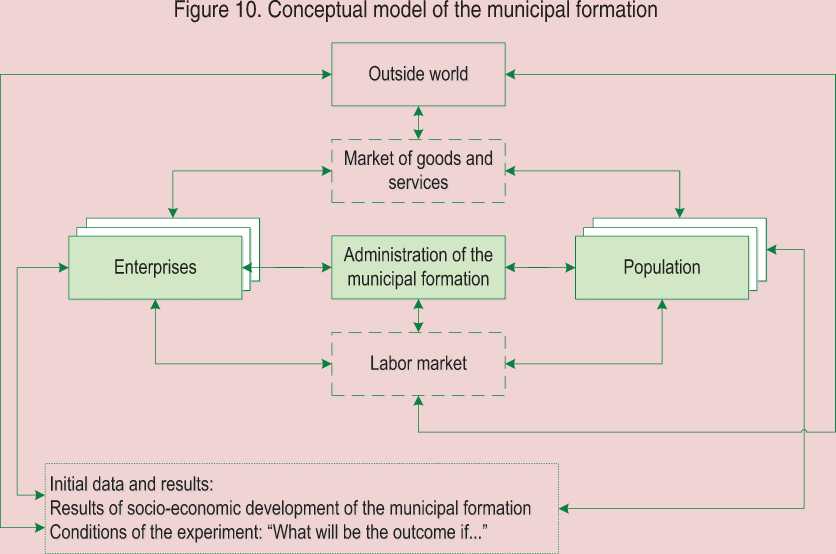
Source: Klebanov B.I., Moskalev I.M., Begunov N.A., Kritskii A.V. Mul’tiagentnaya imitatsionnaya model’ munitsipal’nogo obrazovaniya [Multi-Agent Simulation Model for a Municipal Formation]. Imitatsionnoe modelirovanie. Teoriya i praktika (IMMOD-2007): sbornik dokladov III Vserossiiskoi nauchno-prakticheskoi konferentsii, g. Sankt-Peterburg, 17–19 oktyabrya 2007 g. [Simulation Modeling. Theory and Practice (IMMOD-2007): Collection of Reports of the Third All-Russian Research-to-Practice Conference, Saint Petersburg, October 17–19, 2007]. Saint Petersburg: TsNIITS, 2007. Vol. 2. Pp. 86-90.
Thus, the accumulated domestic and foreign experience of agent-based modeling of complex socio-economic systems of the meso-level consists primarily in the modeling of socio-economic and spatial development of cities, urban agglomerations, suburban districts and other municipal formations. The main agents operating in the models are mostly residents of the municipal formation or they can be households, enterprises and organizations operating on the territory of the municipal formation, including their types such as construction firms, and the government.
The fact that the model includes a specific agent such as the administration of the municipal education provides an opportunity for using them for testing various options of management actions on the territory of the municipal formation due to the changes in controllable parameters of the model, for instance, management of allocation of budget expenditures and taxes, introduction of certain restrictions or issuance of permits (e.g. construction permits), grant and other support of economic entities.
At the same time, the review of foreign and domestic publications on the agent-based modeling of socio-economic processes of the meso-level, allows us to conclude that there are significant problems that hinder the introduction of agent-based models in municipal management practice at the present stage of their development.
The first problem consists in the lack of theoretical and methodological elaboration of agent-based modeling method, in particular, there are significant difficulties associated with calibration, verification and validation of the models constructed. It is pointed out by both Russian and foreign experts. The solution to this problem is possible, in our opinion, by developing the algorithms for calibration of agent-based models, and by creating instructions or recommendations on their verification and validation. However, all this requires consolidation of efforts of the scientific community, and significant labor and time costs.
The second problem is that agent-based models need to be filled with real data. As a result, there emerges the necessity to collect representative data about micro-level agents.
Partially this problem can be solved through the use of opinion polls. However, the methodology of sociological measurements must ensure comparability at various levels of modeling and the possibility of implementing the hierarchical principle of building the models.
The human factor is the third obstacle to the implementation of agent-based models in practice of municipal management. It is necessary to ensure that the government receives the information about the possibilities and prospects of agent-based modeling of socio-economic systems and the feasibility of its use in making management decisions and selecting optimal strategies of public administration.
However, as we see it, all these problems can be solved, and if there is political will, then in the near future, agent-based computer models can enter the practice of public administration and become a kind of cognitive advisors that are able to increase significantly the effectiveness of governance at any level, starting with the level of municipality.
Список литературы Overview of the Russian and foreign experience of agent-based modeling of complex socio-economic systems of the meso-level
- Amelin D.E. Mestnoe samoupravlenie v regional'nom razvitii . Vologda: VNKTs TsEMI RAN, 2006. 182 p.
- Bakhtizin A.R. Agent-orientirovannye modeli ekonomiki . Moscow: Ekonomika, 2008. 279 p.
- Begunov N.A. Modelirovanie razvitiya munitsipal'nykh obrazovanii na osnove agentnogo podkhoda . Sovremennye issledovaniya sotsial'nykh problem: elektronnyi nauchnyi zhurnal , 2011, no. 4, pp. 1-18. Available at: http://sisp.nkras.ru/issues/2011/4/begunov.pdf
- Begunov N.A. Klebanov B.I., Popov E.V. Imitatsionnoe modelirovanie sotsial'no-ekonomicheskogo razvitiya goroda . Zhurnal ekonomicheskoi teorii , 2010, no. 4, pp. 180-183.
- Gulin K.A., Shabunova A.A., Chekmareva E.A. Trudovoi potentsial regiona . Vologda: ISERT RAN, 2009. 84 p.
- Makarov V.L., Bakhtizin A.R., Sushko E.D. Imitatsiya osobennostei reproduktivnogo povedeniya naseleniya v agent-orientirovannoi modeli regiona . Ekonomika regiona , 2015, no. 3, pp. 313-322.
- Makarov V.L., Bakhtizin A.R., Sushko E.D. Komp'yuternoe modelirovanie vzaimodeistviya mezhdu munitsipalitetami, regionami, organami gosudarstvennogo upravleniya . Problemy upravleniya , 2013, no. 6, pp. 31-40.
- Makarov V.L., Sushko E.D., Bakhtizin A.R. Obshchee opisanie demograficheskoi modeli “Rossiya” . Available at: http://abm.center/publications/?ID=278.
- Makarov V.L., Bakhtizin A.R. Sovremennye metody prognozirovaniya posledstvii upravlencheskikh reshenii . Upravlencheskoe konsul'tirovanie , 2015, no. 7, pp. 12-24.
- Makarov V.L., Bakhtizin A.R. Sotsial'noe modelirovanie -novyi komp'yuternyi proryv (agent-orientirovannye modeli) . Moscow: Ekonomika, 2013. 295 p.
- Moskalev I.M., Begunov N.A Servis prognozirovaniya razvitiya ekonomiko-sotsial'nykh protsessov territorial'nykh obrazovanii . Nauchnoe obozrenie: ekonomika i upravlenie , 2012, no. 4, pp. 69-76.
- Klebanov B.I., Moskalev I.M., Begunov N.A., Kritskii A.V. Mul'tiagentnaya imitatsionnaya model' munitsipal'nogo obrazovaniya . Imitatsionnoe modelirovanie. Teoriya i praktika (IMMOD-2007): sbornik dokladov III Vserossiiskoi nauchno-prakticheskoi konferentsii, g. Sankt-Peterburg, 17-19 oktyabrya 2007 g. . Saint Petersburg: TsNIITS, 2007. Vol. 2. Pp. 86-90.
- Musaev A., Shevchik A. Tikhaya kognitivnaya revolyutsiya . Ekspert , 2016, no. 4, pp. 45-51.
- Sushko E.D. Mul'tiagentnaya model' regiona: kontseptsiya, konstruktsiya i realizatsiya: Preprint # WP/2012/292 . Moscow: TsEMI RAN, 2012. 54 p.
- Fattakhov M.R. Agent-orientirovannaya model' sotsial'no-ekonomicheskogo razvitiya megapolisov: avtoref. dis. na soisk. uch. st. k.e.n.: 08.00.13 . Moscow, 2011. 30 p.
- Fattakhov M.R. Agento-orientirovannaya model' sotsial'no-ekonomicheskogo razvitiya Moskvy . Ekonomika i matematicheskie metody , 2013, no. 2, pp. 30-42.
- Agent-Based Models of Geographical Systems. Ed. by A.J. Heppenstall et al. Springer Science+Business Media B.V., 2012. 759 p.
- Batty M. Agents, Cells, and Cities: New Representational Models for Simulating Multiscale Urban Dynamics. Environment and Planning, 2005, vol. 37, pp. 1373-1394.
- Batty M. Fifty Years of Urban Modelling: Macro Statics to Micro Dynamics. The Dynamics of Complex Urban Systems: An Interdisciplinary Approach. Heidelberg: Physica-Verlag, 2008. Pp. 1-20.
- Batty M. Urban Modeling. International Encyclopedia of Human Geography. Oxford: Elsevier, 2009. Pp. 51-58.
- Bures V., Tucnik P. Complex Agent-Based Models: Application of a Constructivism in the Economic Research. Economics & Management, 2014, vol. 17, no. 1, pp. 152-168.
- Deguchi H., Terano T., Kurumatani K., Yuzawa T., Hashimoto S., Matsui H., Sashima A., Kaneda T. Virtual Economy Simulation and Gaming -An Agent Based Approach. JSAI 2001 Workshops, LNAI 2253. Pp. 218-226.
- Deissenberg C., Hoog S., Dawid H. EURACE: A massively parallel agent-based model of the European economy. Applied Mathematics and Computation, 2008, no. 204, pp. 541-552.
- Haase D., Lautenbach S., Seppelt R. Modeling and simulating residential mobility in a shrinking city using an agent-based approach. Environ. Model. Softw., 2010, no. 25, pp. 1225-1240.
- Heath B., Hill R., Ciarallo F. A Survey of Agent-Based Modeling Practices (January 1998 to July 2008). Journal of Artificial Societies and Social Simulation, 2009, no. 12 (4) 9, pp. 1-35.
- Heppenstall A., Malleson N., Crooks A.T. “Space, the Final Frontier”: How Good are Agent-Based Models at Simulating Individuals and Space in Cities? Systems, 2016, no. 4 (1) 9. Available at: http://www.mdpi.com/2079-8954/4/1/9/pdf/
- Legendi R. O., Gulyás L. Replication of the MacroABM Model: Replication Issues in the Context of Economic Agents. 17th Annual Workshop on Economic Heterogeneous Interacting Agents, WEHIA 2012, June 21-23 in Paris, France. 15 p.
- Liu H., Silva E. A. Creative Industries Urban Model: Structure and Functioning. Urban Design and Planning, 2015, vol. 168, no. 2, pp. 88-100.
- Liu H., Silva E. A. Simulating the Dynamics Between the Development of Creative Industries and Urban Spatial Structure: An Agent-Based Model. Planning Support Systems for Sustainable Urban Development. Berlin: Springer, 2013. Pp. 51-72.
- Magliocca N., Safirova E., McConnell V., Walls M. An Economic Agent-Based Model of Coupled Housing and Land Markets (CHALMS). Computers, Environment and Urban Systems, 2011, no. 35, pp. 183-191.
- Čech P., Tučník P., Bureš V., Husráková M. Modelling Complexity of Economic System with Multi-Agent Systems. 5th International Conference on Knowledge Management and Information Sharing (KMIS 13), Vilamoura, Algarve, Portugal, September 19-22, 2013. Pp. 464-469.
- Zhang H., Zeng Y., Bian L., Yu X. Modelling Urban Expansion Using a Multi Agent-Based Model in the City of Changsha. Journal of Geographical Sciences, 2010, vol. 20, no. 4, pp. 540-556.
- Rui Y., Ban Y. Multi-agent Simulation for Modeling Urban Sprawl In the Greater Toronto Area. Proc. of the 13th AGILE International Conference on Geographic Information Science. -Guimarães (Portugal), 2010. Available at: https://agile-online.org/Conference_Paper/CDs/agile_2010/ShortPapers_PDF/124_DOC.pdf
- Sun S., Manson S.M. Simple Agents, Emergent City: Agent-Based Modeling of Intraurban Migration. Computational Approaches for Urban Environments. Berlin: Springer, 2015. Pp. 123-147.

